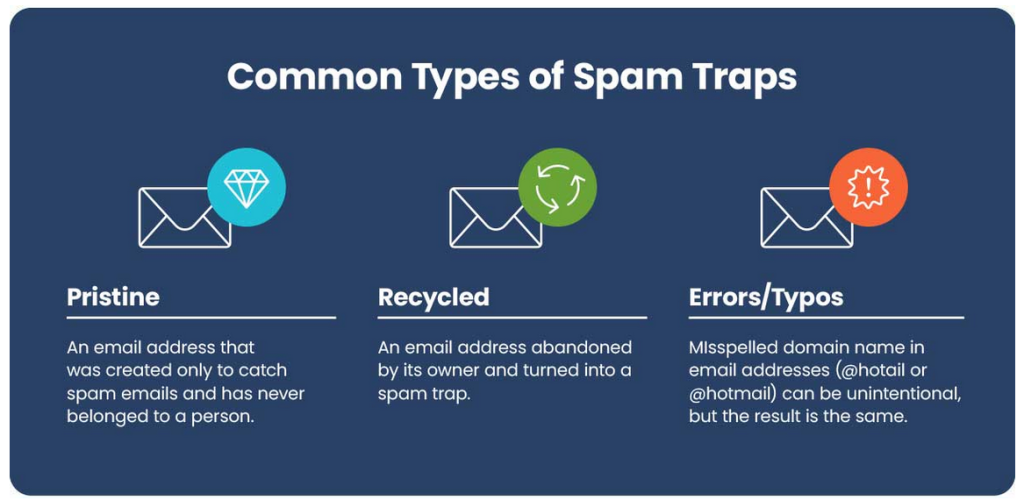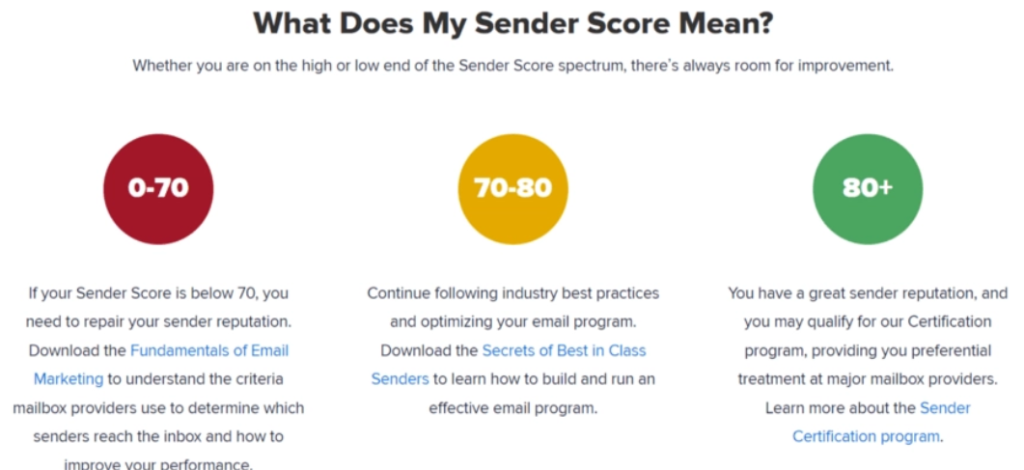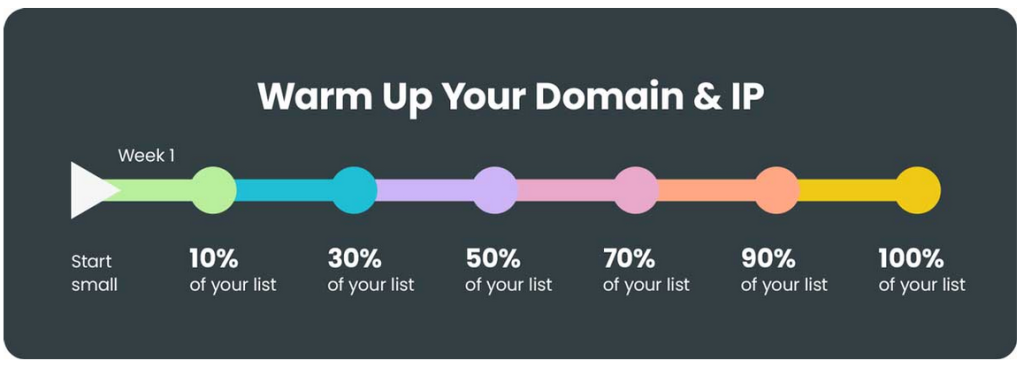- Home
- Fundamentals of Email Marketing
- How To Check and Fix Email Dom ...

Email filtering has evolved, and by 2025, email domain reputation plays a more pivotal role than ever. Historically, the reputation of the IP address sending the email was king—but that’s no longer the case. Today, mailbox providers place far more weight on domain reputation because, while IPs can shift, your domain stays with you. And that makes it the true digital fingerprint of your sender identity.
That’s why it’s crucial to understand not only the importance of email domain reputation but also how to maintain it, monitor it, and course-correct when things go wrong. In this article, we’ll explore why domain reputation matters in email marketing, how to check email domain reputation, and what to do if your score needs help.
What Is Domain Reputation and Why It Matters
Domain reputation is the overall perception of your sending domain’s trustworthiness in the eyes of email providers. In other words, it’s the “health” of your domain based on its sending history—things like how often people mark your emails as spam, whether you hit any spam traps, and how many of your messages bounce or get ignored. Mailbox providers use this reputation score to decide if your emails land in the inbox or get filtered out. For email marketers, domain reputation is critical: with inbox competition so high, a poor reputation can tank your campaigns.
How Domain Reputation Works in 2025
Every major internet service provider (ISP) and mailbox provider (like Gmail, Outlook, Yahoo, etc.) maintains its own reputation profile for your domain—there’s no single universal score. This means your domain might be viewed as “good” by Gmail but only “okay” by Outlook, depending on your sending behavior with each.

Engagement is key
One of the most important factors affecting your email/domain reputation today is recipient engagement. ISPs track how users interact with your emails as a measure of whether those emails are wanted. If people open your messages, click links, reply, forward, or move them out of the spam folder, it sends a positive signal that boosts your sender reputation. It improves inbox placement for future messages and increases the chances of your next campaign landing in inboxes rather than promotions or spam. On the flip side, lack of engagement hurts your domain reputation.
For email marketers, this means focusing on subscriber interaction: send content your audience finds valuable, prune out unengaged contacts, and perhaps even encourage actions (like asking a question to prompt replies).
Email authentication basics
Email authentication includes technical settings that prove your emails are legitimately from your domain and haven’t been tampered with. The three core email authentication protocols are SPF, DKIM, and DMARC:
- SPF (Sender Policy Framework): This is a DNS record that lists which mail servers are authorized to send emails on behalf of your domain. When an email server like Gmail or Outlook receives a message claiming to be from your domain, it checks the SPF record to see if the sending server’s IP address is on the list. If the IP isn’t authorized, the SPF check fails and the message might be rejected or flagged as spam.
- DKIM (DomainKeys Identified Mail): DKIM adds a digital signature to every email sent from your domain. It works via a pair of cryptographic keys: you publish a public key in your DNS, and your email system attaches a private-key signature header to each outgoing email. The receiving server will retrieve your public key from DNS and use it to verify that the signature is valid. If it is, that proves the email hasn’t been altered in transit and really comes from your domain.
- DMARC (Domain-based Message Authentication, Reporting & Conformance): DMARC builds on SPF and DKIM by enforcing alignment and providing instructions to receivers. It’s a DNS policy that says, “If an email fails SPF and/or DKIM checks, here’s what to do with it (reject it, quarantine it, or do nothing) and send me a report.” Crucially, DMARC requires the From address domain to align with the domain authenticated by SPF/DKIM. This prevents scammers from using your domain in the From line if they can’t pass SPF/DKIM.
You can find more information on how to implement authentication protocols here.
Send consistently, not sporadically
Another important aspect of maintaining a good email reputation is consistency in your sending patterns. Mailbox providers pay attention not only to what you send but also to how often and how much you send. If you normally send 5,000 emails a week and then one day try to send 50,000, that’s a red flag for spam filters. To avoid this, establish a consistent sending cadence.
In practical terms, that means planning your campaigns on a regular schedule and avoiding extreme peaks and valleys in send volume. It also means keeping a regular frequency that your subscribers anticipate—if subscribers suddenly get an email after a long dormancy, they might not recall signing up and could mark it as spam.
Managing bounces effectively
An email bounce means a message you sent was not delivered and was returned by the recipient’s mail server. There are two types of bounces: hard bounces (permanent failures, such as “address does not exist”) and soft bounces (temporary issues, such as “mailbox full” or “server down”). Both happen for a range of reasons.
To protect your domain, you need to manage bounces proactively:
- Reduce bounces at the source: Use confirmed (double) opt-in for new subscribers so that people have to provide a valid email and confirm it. This catches typos or fake addresses early. You can also use an email validation service periodically to weed out invalid addresses before sending.
- Remove hard bounces immediately: Most email platforms will automatically suppress emails that hard bounced (e.g., “user not found”). Ensure this is happening so you’re not repeatedly sending to dead addresses.
- Monitor soft bounces: If an address soft-bounces for three campaigns in a row, consider dropping or at least suspending it. Prolonged soft bounces might turn into hard bounces eventually.
- Keep your list clean: Regular list hygiene is critical. If someone hasn’t engaged for a long time and also doesn’t respond to re-engagement attempts, it may be worth removing them to minimize future bounces or spam complaints.
Build your list the right way
Building your list organically (through opt-in signups) is the only safe way. If instead you buy or rent an email list, you’re almost guaranteeing yourself reputation problems and more. Purchased lists typically contain people who have never heard of your brand along with invalid or old addresses and even planted spam traps. All of these outcomes will severely hurt your email domain reputation.
In fact, the performance of purchased lists is notoriously poor. One study found that emails sent to purchased contacts had open rates as low as 1 percent, whereas a healthy, organically grown list can see open rates in the 20–30 percent range. A small list of genuinely interested subscribers is far more valuable than a huge list of strangers.
Watch for spam traps
There are pristine spam traps (email addresses that were never valid for a real user—often created solely as trap addresses) and recycled traps (addresses that once were real but have long been abandoned and converted into traps by an ISP or blacklist). Hitting either type of spam trap is very bad news. It indicates that you might be sending to addresses that were obtained without proper consent or that you’re not removing inactive emails.

How to avoid spam traps?
⚠️ Never buy or harvest email addresses from the internet. Spam trap addresses are often scattered on websites waiting for scrapers.
⚠️ Use confirmed opt-in (double opt-in). This way, even if someone signs up with a fake or misspelled address that turns out to be a trap, the trap won’t confirm the subscription and won’t get on your list.
⚠️ Regularly clean your list of old, unengaged contacts. Many recycled traps come from addresses that were inactive for a long time. This practice would remove addresses before they turn into traps.
⚠️ Monitor bounce responses and complaints. Sometimes ISPs give hints when an address is a trap (for instance, a peculiar bounce message).
Must-have technical settings
Getting the technical setup right is just as important as content and list quality when it comes to protecting your domain’s reputation. Ensure the following technical elements are in place and properly configured:
- Authenticate your emails (SPF, DKIM, DMARC): Proper authentication not only helps prevent spoofing of your domain, it also boosts receivers’ confidence that your mail is legit.
- Enable easy unsubscribes: Every marketing email you send should include a clear unsubscribe link and ideally a list-unsubscribe header as well. Making it easy for users to opt out means they are less likely to hit the Report Spam button out of frustration.
- Use a consistent sending domain: Send from a consistent domain name (or set of domains). Don’t constantly change your From address domain in an attempt to dodge filters—it won’t work. Pick a domain (or subdomain) for your email campaigns and stick with it.
- Set up feedback loops (FBLs): A feedback loop is a service offered by some ISPs where they inform you (the sender) whenever a user marks your email as spam. By signing up for FBLs, you can get data on spam complaints and promptly remove those complainers from your list, preventing further damage.
Easy Ways to Check Your Domain Reputation
How can you tell what your current domain reputation is? Fortunately, there are tools and services specifically for this. Here are some of the easiest and most effective ways to check email domain reputation:
✅ Google Postmaster Tools (GPT): It is a free service that gives direct insight into how Gmail perceives your domain. Once you verify ownership of your sending domain, you get access to dashboards on key metrics. The most critical one is the Domain Reputation dashboard, which shows a color-coded rating of your domain’s reputation for Gmail traffic (ranging from Bad, Low, Medium to High).
✅ Microsoft SNDS: This is a similar platform for Outlook/Hotmail/Live mail traffic. By enrolling the IPs you send from, you can see data like how many Outlook addresses you sent to, your complaint rates from those users, and whether Microsoft’s filters are seeing any issues.
✅ Third-party reputation checkers: Third-party reputation checkers like Sender Score, Talos Intelligence, and Barracuda Reputation offer quick insights into your domain or IP reputation. Sender Score rates you from 0 to 100, while Talos and Barracuda classify your domain as Good, Neutral, or Poor and show whether you’re listed on major blocklists. These email domain reputation checkers help you spot potential issues before they affect your deliverability.

In practice, you’ll likely use a combination of these tools for domain reputation check, and if something starts to go wrong, you can take corrective action before your domain gets to Bad or emails start outright bouncing.
How to Build a Strong Domain Reputation from Scratch
When launching email sending from a brand-new domain, you essentially start from zero. Here’s how to build a strong domain reputation from scratch:
- Warm up your domain: Begin by sending small volumes of email and gradually increase over a period of weeks. This warm-up period allows you to establish a positive sending history without triggering alarms. Mailbox providers notice sudden volume from new domains, so slow and steady wins the race.

- Implement best practices from day 1: ISPs subject new senders to heightened scrutiny, so you need to do your best from the start. That means setting up authentication protocols before you send the first email, ensuring your email list is truly opt-in, and basically following all the advice in this article from the very start.
- Leverage engagement early: Since engagement is so crucial, consider tactics to boost interaction for your initial sends. You might send a “Hello from [Brand]” email to new subscribers that encourages them to reply with a question or click to set preferences. Even a small positive action from users can help establish your domain as legitimate.
- Be extra careful with initial content and audience: For your first few campaigns, send your very best content to your most reliable recipients. Start with a segment like “new customers in the last 3 months” or those who specifically requested to join your mailing list. Once your domain builds up a bit of positive reputation, you can ease into harder-selling content if that’s part of your strategy.
Building a strong email reputation from scratch takes a bit of time and patience, but it’s far easier to build it right from the beginning than to repair it later.
How to Fix a Damaged Domain Reputation
If your domain has been flagged, placed on blacklists, or is consistently going to spam, you need to rehabilitate its reputation step by step. Here’s how to improve email domain reputation after it’s taken a hit:
- Stop and diagnose: If a particular campaign or practice led to a wave of spam complaints or a blacklist listing, pause your sending. Examine your data and feedback around the time things went south. This will help to identify the likely cause and suggest the solution.
- Clean up your mailing list: Remove any addresses that hard bounced and those who have not engaged in a long time. Also, isolate or eliminate any part of the list that you suspect to be problematic (e.g., a purchased segment).
- Fix technical and content issues: Ensure your SPF, DKIM, and DMARC are all correctly configured. Remove any elements that might trigger spam filters (certain spammy keywords, deceptive subject lines, etc.). If you hadn’t been including an unsubscribe link or physical address (as per the CAN-SPAM Act), absolutely add those now.
- Gradually resume sending: Even though your domain isn’t new, you have to treat it like it has zero reputation and prove yourself again. Start by sending to a small segment of your best, most engaged subscribers. The goal is to get some good engagement metrics and no complaints with this “seed” group. Once that’s successful, expand the circle a bit wider to the next most engaged group.
- Seek delisting from blacklists: If your domain ended up on any major blacklists, go through their removal process. Some automated lists will drop you off naturally after some time if no further spam is seen. But others require manual intervention. Once delisted, be extremely careful not to relapse—getting listed a second time shortly after will make it harder to ever be removed again.
Lastly, avoid any shortcuts like switching to a new domain. The only real solution is to reform your sending practices, as outlined above, and slowly rebuild trust. It’s certainly possible—senders do come back from the spam folder all the time—but it requires a commitment to best practices going forward.
To Sum Up
The bottom line: in 2025, maintaining email domain reputation means playing by the rules—authenticate your emails, send content people actually want, and keep complaints and bounces to a minimum. The algorithms are less forgiving now, but the good news is: transparency has improved. With tools that let you check email reputation regularly, responsible senders now have a much clearer path toward building (and keeping) a strong domain reputation that stands the test of time.



